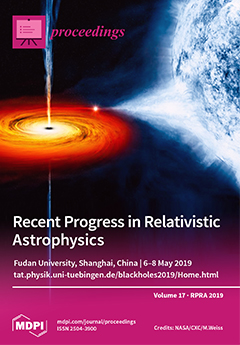Need Help?
Proceedings, 2019, RPRA 2019
Recent Progress in Relativistic Astrophysics
Fudan University, Shanghai, China | 6–8 May 2019
Volume Editors:
Cosimo Bambi, Fudan University, China
Sourabh Nampalliwar, Eberhard-Karls Universität Tübingen, Germany
- Issues are regarded as officially published after their release is announced to the table of contents alert mailing list.
- You may sign up for e-mail alerts to receive table of contents of newly released issues.
- PDF is the official format for papers published in both, html and pdf forms. To view the papers in pdf format, click on the "PDF Full-text" link, and use the free Adobe Reader to open them.
Cover Story (view full-size image):
Black holes and neutron stars are the most extreme objects that can be found today in the Universe and ideal laboratories for testing fundamental physics. Thanks to new observations facilities, in
[...] Read more.
Black holes and neutron stars are the most extreme objects that can be found today in the Universe and ideal laboratories for testing fundamental physics. Thanks to new observations facilities, in the past 20 years there has been tremendous progress in our understanding of these objects and of their astrophysical environment. Recent detections of gravitational waves by the LIGO and Virgo experiments and the first image of a black hole by EHT have presented new opportunities to study these systems. While some questions have been addressed, others are still open, and new questions have arisen. The aim of this volume is to review recent progress in relativistic astrophysics and to outline future directions.
Previous Issue
Next Issue
Issue View Metrics
Multiple requests from the same IP address are counted as one view.



